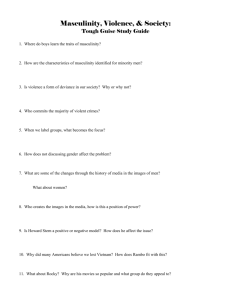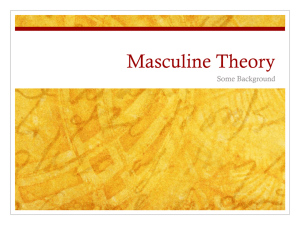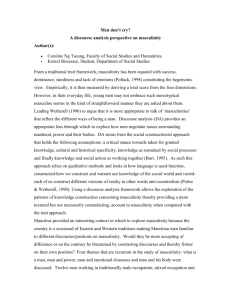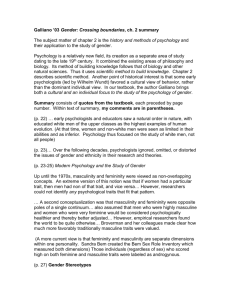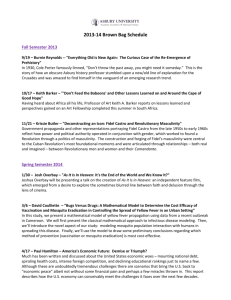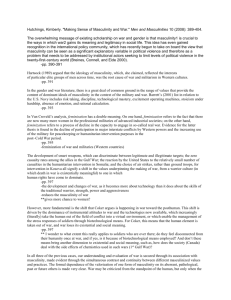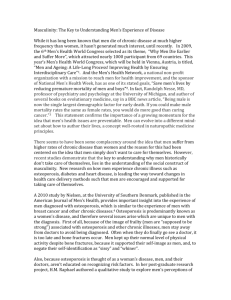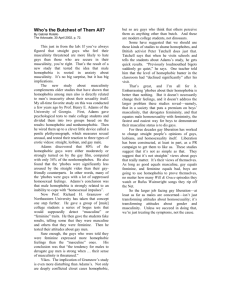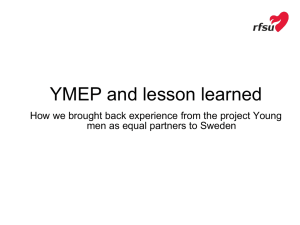Melissa Riggio Final Long Paper for Gender Studies Minor
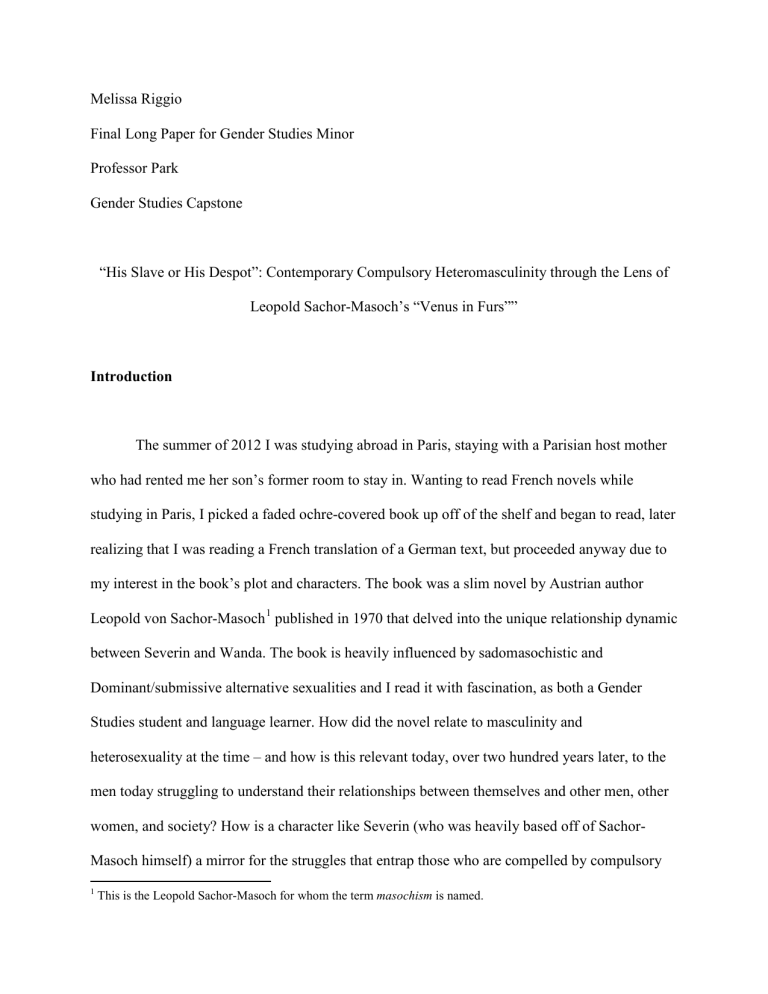
Melissa Riggio
Final Long Paper for Gender Studies Minor
Professor Park
Gender Studies Capstone
“His Slave or His Despot”: Contemporary Compulsory Heteromasculinity through the Lens of
Leopold Sachor-Masoch’s “Venus in Furs””
Introduction
The summer of 2012 I was studying abroad in Paris, staying with a Parisian host mother who had rented me her son’s former room to stay in. Wanting to read French novels while studying in Paris, I picked a faded ochre-covered book up off of the shelf and began to read, later realizing that I was reading a French translation of a German text, but proceeded anyway due to my interest in the book’s plot and characters. The book was a slim novel by Austrian author
Leopold von Sachor-Masoch
published in 1970 that delved into the unique relationship dynamic between Severin and Wanda. The book is heavily influenced by sadomasochistic and
Dominant/submissive alternative sexualities and I read it with fascination, as both a Gender
Studies student and language learner. How did the novel relate to masculinity and heterosexuality at the time – and how is this relevant today, over two hundred years later, to the men today struggling to understand their relationships between themselves and other men, other women, and society? How is a character like Severin (who was heavily based off of Sachor-
Masoch himself) a mirror for the struggles that entrap those who are compelled by compulsory
1
This is the Leopold Sachor-Masoch for whom the term masochism is named.
heterosexuality to act in certain ways? I saw many parallels between the thoughts and feelings of the main character and the men I knew in my life, when I was privileged enough to hear their true intimate thoughts. I was curious to know what theory and academia backed up my personal experiences and the experiences recorded in this book (which was fairly autobiographical).
The basic plot of the book is, at its core, a simple story. Severin von Kusiemski meets
Wanda von Dunajew and asks her to make him her slave, and to treat him in a sexually degrading manner.
His masochistic sexual desires are at first off-putting to Wanda, who is not particularly interested herself in being sexually dominant, but goes along with it to humor him, but at the same time scorns his actions. Throughout the novel his masculinity is constantly at odds with his sexual desires to submit, which is contrary to the common Western masculinityheterosexuality construct that I discuss at length throughout this piece. In the end, Wanda leaves
Severin to submit to a Byronic hero figure, the Greek Alexis Papadopolis, a stereotypical dominant, masculine male. This crushes Severin, and he is humiliated by this turn of events, as well as the actual physical humiliation he endures though a whipping by Alexis
. In the whipping scene Alexis performs as a strong, dominant, cruel, and completely indifferent to the pain he is causing, all of which is perfect for Wanda’s “ideal man” and the sexuality of the “ideal man”.
Severin muses at the end that “That woman, as nature has created her, and man at present is educating her, is man's enemy. She can only be his slave or his despot, but never his companion.
This she can become only when she has the same rights as he and is his equal in education and work.”
I found this line to be so important that it merited a part of the title, hence “His Slave or
2 Clearly this is tied in with sadomasochistic desires, but official BDSM at this point in history was not as strongly linked to community and psychosexual understanding like it is today.
Therefore, there will be no discussions of the BDSM ramifications of the novel within this thesis.
3
Sacher-Masoch, Leopold, and Joachim Neugroschel. Venus in Furs. New York: Penguin, 2000. Print. Page 112
4
Ibid. 114
his Despot”.
Proposal: What will this work accomplish?
In this thesis, I will examine how male heterosexuality is closely linked with
“masculinity” (which I will later define much more in depth), and how the compulsory heteromasculinity of the Western World affects not only heterosexual men’s relationships with women but also with other men, and ultimately how they view themselves as beings in society.
My main argument is that masculinity is inextricably associated with heterosexuality, and I support that argument with examples of studies in which men discuss how they feel compelled to be masculine to prove their heterosexuality, as well as pointing out the reflections of these thoughts in Venus in Furs, a book published in 1870 but still very reflective of the heteromasculine structure of contemporary Western men.
There are several limitations to this thesis that I must address. First of all, I could not possibly begin to address all masculinities from every single culture in the world. Thus, when I say “masculinity”, I am referring to the masculinity of the body of work that I researched- that is,
Western, working to middle to upper class heterosexual men, majority white, from countries such as the United Kingdom and the United States. Secondly, I understand that I am combining a work published in 1870 with more contemporary studies ranging from the 1980’s to the 2000’s.
This was done on purpose; I often use this gap in time to make my point about the definition of masculinity throughout the past few hundred years. In this historical context, the demands and expectations of masculinity on heterosexual men have not changed very much at all.
My limitations regarding how I use the term ‘masculinity’ will be addressed when I speak of Judith/Jack Halberstam’s work regarding ‘othered’ masculinities, which is non-white and non-
male masculinities. It is important to remember that while white male masculinity is held to be the standard due to the oppressive nature of whiteness and maleness, that does not justify its seemingly “natural” existence. I deconstruct this ideal of “natural” masculinity as I observe how many the men in the studies, novel, and theory struggle with the demands of masculinity.
Definitions: What is “masculinity”, “heterosexuality”, and “heteromasculinity”?
Three terms will be used often in this piece- masculinity, heterosexuality, and the merging of the two, heteromasculinity. I will define these terms as I have thus studied them and wish to note that it is impossible to create a standard, agreed upon definition for these terms as all concepts are shifting with changing attitudes towards gender, but most importantly always seem to have the same several core values, which I will discuss later. . Thus, when I use term
“masculine” or “masculinity” in this essay, it will refer back to this definition I have here. There are four schools of thought into what the definition of “masculinity” is (Connell 2005), which I will summarize here.
Masculinity, according to Connell, is a very unclear term. For instance, “all societies have cultural accounts of gender, but not all have the concept ‘masculinity’”
. Connell argues that ‘masculinity’ cannot exist without the contrast of ‘femininity’. Before the most recent several hundred years women were regarded as “different” not due to their individual traits but due to that they were “inferior” to men- something was lacking from them that did not make them complete. If they were complete then they would be men, but incomplete as they were, they were then assigned the label “women”. This sort of thought associated with the genders put the
5
Connell, Raewyn. Masculinities. Berkeley: U of California, 1995. Print. Page 67
two in “different spheres” according to Connell and only furthered the assumption of difference between men and women.
Connell goes on to say that four main strategies for characterizing the type of person that is masculine is as follows: Essentialist, positivist, normative, and semiotic. I will briefly define each and state their difficulties.
Essentialist definitions “usually pick a feature that defines the core of the masculine, and hang an account of men’s lives on that”
. Simply put, one characteristic is picked, such as “risktaking, responsibility, irresponsibility, aggression, Zeus energy”. Connell mentions that the main weakness of Essentialist definitions of masculinity stem from the obvious: it is frankly arbitrary which characteristic is picked.
Positivist definitions use psychology and statistics to define what men are, as positivist social science strives to be as factual and accurate as possible. However, it is impossible to be neutral in trying to define what is masculine (and in effect by defining masculine one also defines what is feminine). Secondly, already sorting men and women into “men and women” categories predefines what you see as masculine and feminine. This procedure “rests on the very typifications that are supposedly under investigation in gender research”. Third, some women are called “masculine” and some men “feminine”- but does it not become a contradiction in itself to define these people as performing the opposite gender, if the trait they are performing is what is associated with the opposite gender? I address this soon when speaking about the work of
Judith/Jack Halberstam.
Normative definitions offer a standard for what men ought to be. Connell lists standards found in media studies, such as John Wayne or thriller genres. However, this causes a multitude
6
Connell, Raewyn. Masculinities. Berkeley: U of California, 1995. Print. Page 68
of problems. How can one meet an impossible standard- does that mean that any man who does not meet this impossible standard (like all men) are they no longer men?
Semiotic definitions of masculinity are simply the opposite of definitions of femininity.
This is done for linguistic simplification purposes- whatever is unfeminine is masculine, and vice versa. I will not be using this often in my essay, as it is not as common of a definition as the others.
I’ll refer back to these definitions as they arise in the literary analysis and case studies that are to follow. Since all of these definitions are inherently flawed, it is important to remember that it is impossible to rely wholly on one, and one must instead take pieces of truth from all of them, albeit with caution.
Heteromasculinity is a fairly new concept in academia and thus is still developing its definition. In this work heteromasculinity will be defined as the cultural concept of the inextricable entanglement between masculinity and heterosexuality. This expectation of heterosexual men performing masculine traits ties in directly with homosocial relations as well as heterosexual relations. This work will address how heteromasculinity is enforced by other men, ensuring that masculinity and heterosexuality are kept closely linked and tangled.
It is important to note the context in which I put “masculinity”. For example, I am referring to the term as it has become to mean in Western society performed by heterosexual men. Here it is important to contrast what I am studying with masculinity with the work of
Judith/Jack Halberstam, whose work “Feminine Masculinity” details the different kinds of masculinities that manifest, even when those that manifest are not from males.
Halberstam notes that “What we call ‘dominant masculinity’ appears to be a naturalized relation between maleness and power,” and goes on to say that in order to properly study
masculinity one must examine masculinity outside of the white middle class male body
. That is almost exactly what I am doing in my thesis; However I acknowledge here that there is more to masculinity than what white men perform. What we define as “masculine” with those who are not male is based off of what our assumption of what men do- this is result of the Positivist or
Essentialist definition of masculinity. Therefore I find it worth studying further, especially with the new studies that come out, and in relation to “Venus in Furs”, as it was published over a hundred years ago but still rings very true to the inner fears of heterosexual men today.
Halberstam does make a strong and interesting point regarding characterizing those who are already ‘othered’ by Western society as either hypermasculine or insufficiently masculine.
He/she points out that “Black bodies (both male and female), latino/a bodies, or working class bodies” are given the label of excessively masculine, while “Asian bodies and upper-class bodies” are given the label of insufficiently feminine
. What traits are picked out of the aforementioned bodies as “masculine” or not are extremely subjective, and therefore make it difficult to create a solid definition of what masculinity is and must be. Halberstam notes this but goes on to say that this is difficult because of the ‘othering’ that white male middle class masculinity has forced upon the minority masculinities.
Halberstam mentions that there are indeed ways to study the white male masculinity, but so far (as of 1998, when this work was written
) none of them have been seriously examined.
He/she brings up “producing ethnographies on the aggressive and indeed protofacist masculinities produced by male sports fans” as well as work on “the socialization (or lack
7
Halberstam, Judith. Female Masculinity. Durham: Duke UP, 1998. Print. Page 2
8
Ibid 2
9
Since then many works have been written about masculinity studies, as seen by the abundance of studies involving men and masculinity I used for my research here. However at the time of Halberstam’s work she/he felt that there were not enough in the field.
thereof) of young men in high schools”, and “the new sexism embodied by “sensitive men”
. It is interesting that of the things she mentions not being readily accessible, several of the studies I will research in this work are exactly studying that. The new sexism manifests itself in the hair salon study and the multiple youth studies such as the fraternity study, the the Christans and
Goths study, and the Scottish high school study. In the years since Halberstam first wrote
“Female Masculinity” there has been enough study of the very ethnographies that he/she pointed out as lacking to once again engage in the discourse of white male heterosexuality.
Therefore I am now making it clear that I am discussing the white, Western, male masculinity, and its connection to white male heterosexuality. While the others merit much discussion and discourse, this study focuses on white heterosexual males. When I refer to
“masculine” in the rest of the work, I am referring to the aforementioned definition.
My argument is that in Western society, it is taboo to perform as a heterosexual man in any other way than in a Western white male masculine manner. However, this reinforcement of heteromasculine norms is done out of fear of humiliation from other men, and often the men admit to not wanting to perform masculine traits. This constant fear and assumption of humiliation from other males if weakness is shown creates a hostile social and sexual environment for both sexes. Nearly all of the men I read interviews from in this work expressed a trapped or struggling feeling when it comes to performing masculine traits, and I will explore how some men chose to change themselves by distancing themselves from ‘other men’ and the masculine definition they were saddled with.
Before I discuss case studies and literary analysis of Venus in Furs, I will bring forth theory that will remain relevant to refer to throughout the thesis. I will begin with Paul Theroux,
10
Halberstam, Judith. Female Masculinity. Durham: Duke UP, 1998. Print. Page 19
11
Without leaders in the field such as Halberstam and Connell these future studies may not have come into existence, and their hard work is acknowledged throughout the masculinity studies seen today.
who writes on the oppression of masculinity, and then move on to Michel Foucault, who remarks upon the phenomenon when one’s sexuality is used to define one’s personality and characteristics.
Paul Theroux, a writer, discusses in his work “Being a Man”
how much he has
“disliked being a man”, much of which ties into the oppressive heteromasculinity I have discussed thus far (without using the term in his work). He discusses how masculinity is like an ill-fitting coat, and how femininity is like “oppressive sense of nakedness”. In the work he goes on to describe how the forced masculinity of Western culture through sports and a lack of “easy friendship” that women have that men don’t lead to a depressive state. He goes on to say how he had the “guilty secret” of wanting to be a writer, speaking of how even a brilliant writer like
Hemingway was constantly forced to prove his masculinity through drinking and fighting, just as women today have to prove their “motherhood” to publishers in order to be published.
This is where the “masculine” part of compelled heteromasculinity - when doing something seen as “soft”, a man must make up for it by being rough, dominant, or adventurously risky. For this he examined the “about the author” profiles on the backs of books, noting the differences, and came to the aforementioned conclusion. In the end, he brings up that women should not want to be equal to being a man, for it is not much better than being a woman. He claims that this is why many men object so much to feminism – it will force them to see that their lives are just as bad.
I find this relevant to this thesis, as we have seen how masculinity is
12
Theroux, Paul. “Being a Man” Sunrise with Seamonsters . New York: Houghton Mifflin,
1985.
13
It is interesting to note that he defines women’s sense of oppression (the nakedness) and then claims that women ought not to want equality, as men have it worse or just as bad. This entitlement to defining one’s own status as worse when the male gender is seen as the “default” in many cases (“women are ‘weaker’ than men’” or “women make 77 cents to the male dollar”- always the standard) is a mark of the privilege that Theroux enjoys but does not realize that he does. While the masculine disadvantages are clearly spelled out throughout this work, Theroux’s flawed analysis of men’s status in regards to women must be acknowledged here before continuing.
both oppressing for women and men, and how the existence of the compelled heteromasculinity benefits no one. This “ill-fitting coat” that Theroux speaks of is the self-policing masculinity that occurs in homosocial contexts, something I will address later with case studies and my literary analysis. Moving on from just discussing masculinity, French theorist Michel Foucault addresses the phenomenon of humans being characterized by their sexuality instead of having their sexuality as an additional to their whole personality. This idea ties in with heteromasculinity and the definition of masculinity.
Foucault goes at lengths to define power in relations to sexual definitions in his “History of Sexuality
. As we have seen thus far in this work that heterosexuality is the dominant sexuality, and that male heterosexuality is even more so held as the standard, it is important to analyze all of the aforementioned case studies and Venus in Furs through the theories of
Foucault.
Foucault remarks that the extent of discussion of sexuality has increased over time, and that the days of your sexuality being simply a fact about yourself, such as what you eat or what you wear, are gone
. According to Foucault, now a person is defined according to their sexuality- a homosexual instead of a person who is homosexual, for example. Such labeling leads to believing that one’s sexuality is what defines oneself- all homosexuals do this, that, and so on, because their sexuality is what causes them to perform in such a manner, and therefore they have these characteristics. The definition of masculinity we see here is a positivist definition
- a man is heterosexual and therefore is “masculine”, as that man’s sexuality is what gives him those characteristics, according to this definition of sexuality. As noted earlier, this definition
14
Foucault, Michel, Michel Foucault, Michel Foucault, and Michel Foucault. The History of Sexuality. New York:
Pantheon, 1978. Print. Page 6
15
Ibid 36
becomes cyclical- what a man performs is what makes a man- but does that mean everyone that fits the definition of “man” must perform what one man or a group of men once performed?
This can be easily transferred to my argument that male Western heterosexuality is so closely linked to masculinity- one cannot exist without the other, or so it feels. A heterosexual man must be masculine, according to the case studies that have men saying how much masculine traits play into their daily lives as heterosexual men.
This concept ties in with other parts of Foucault’s “History of Sexuality” work; for example, sexuality as a construct and not something inherently inside of the human being’s consciousness
. A man’s heterosexuality is outside of himself- the masculine traits associated with that are not there because he is a man, but rather that the sexuality has been attached to him as his heterosexuality, and with the heteromasculinity concept I have been discussing his heterosexuality is automatically linked to his supposed masculinity. This is why it is such a trouble when he deviates from masculinity, such as when Paul Theroux wanted to work as a writer in the humanities, a “soft” discipline. He felt he had to “make up” for it with rough behavior, which to him redeemed his heterosexuality. He did this so that other men would not believe him to be unmasculine and therefore not heterosexual. In the next section I will show contemporary studies that both reinforce and further the theory explained here, as well as tie in well with “Venus in Furs”.
16
Foucault, Michel, Michel Foucault, Michel Foucault, and Michel Foucault. The History of Sexuality. New York:
Pantheon, 1978. Print. Page 56
Men with Other Men: Homosociality reinforcing Heteromasculinity
I have found and analyzed several studies of either youth males or middle-aged men discussing sexuality, heterosexuality, and what masculinity means to them. They do not necessarily use those terms, but the way they describe their interactions with other men as well as women clearly displays how they feel about the concepts of masculinity and heteromasculinity.
In a study
where the researcher, Scott Kiesling, went into a fraternity and recorded conversations, analyzing homosocial desires between the members, the researcher noted that there was a constant competitive, dominating mood between the members constantly trying to establish authority
. Kiesling describes the tension between the constant competition and the simultaneous desire for homosocial contact as contradictory. The group mentality is often one of the reasons why the men joined the fraternity in the first place, for the homosocial contact and friendships acquired through constant contact.
However, there is a line drawn between acceptable male homosocial relationships and non-acceptable ones- and the line is affection or intimacy, which, ironically, is what many men in the other studies mentioned they craved. In a speech made by one of the fraternity leaders, it was pointed out that many of the members joined the fraternity for the exact purpose of homosocial relationships - but, as Kiesling observed in one-on-one discussions between members, they had to constantly guard themselves from sounding too intimate with other members. Kiesling remarks once that the group leader said “I love you” during a speech to the group but never heard this among members to each other as individuals- it was always with
17
Homosocial Desire in Men's Talk: Balancing and Re-Creating Cultural Discourses of Masculinity, Scott Fabius
Kiesling Language in Society , Vol. 34, No. 5 (Nov., 2005) , pp. 695-726 Published by: Cambridge University Press
18
Ibid 8
multiple individuals
. The fear of being seen as emotional, or weak, ties back to the essentialist definition of masculinity- one must have the core trait of “aloof” or “emotionally distant” to be masculine. This harkens back to Paul Theroux, who mentioning having to tread carefully so as not to seem “unmasculine.” This is also tied to a fear of homosexuality; since homosexual men are seen as feminine, anything that could be perceived as romantic affection towards another male is immediately deemed homosexual. This combination of fear as being seen as affectionate and vulnerable tied with the fear of being seen as homosexual (feminine, and thus one step closer to being seen as a woman) is prominently displayed in these comparisons between group and one-on-one settings.
The competition between young men shifts to manifest differently as they grow. In this next study
, fathers encourage their sons to be heterosexual, which is the dominant sexuality, so that they either do not suffer from the social stigmas of being homosexual or so that they reflect their fathers, who are seemingly all proud of being heterosexual and “manly”. To them, they take on the Essentialist definition of masculinity, and the one core characteristic of masculinity they choose to apply to their sons is the women-chasing or football-playing characteristics. One father admitted to “worrying about the softness” when his son was timid when he was younger, and that the father was “just hoping and praying that [his son] [was] straight”
. This too is result of the essentialist definition as well as the positivist definition of masculinity- men are sporty, men play sports- and if you are a heterosexual man, these naturally play into your sexuality and masculinity. This relates back to the fraternity study, where the fear of being seen as anything other than straight played into the direct daily actions that the men took to avoid being overly
19
Ibid 30
20
''We Want Them to Be as Heterosexual as Possible'': Fathers Talk about Their Teen Children's Sexuality
Nicholas Solebello and Sinikka Elliott
Gender & Society 2011 25: 293
21
Ibid 13
affectionate to their fellow fraternity brothers. Here, the father saw possible signs of femininity
(“softness”) and perceived it as a deviation from the natural and norm of “masculinity”.
That is just one example in the study that revealed how some fathers see their sons as extensions of themselves and thus their heteromasculinity, and if their sons were not to be heterosexual, it would be seen having “failed” on the father’s part. One father even said “We want them [our sons] to be as heterosexual as possible”
. For a father to admit that there were degrees of heterosexuality, and that they wanted the pinnacle of heterosexuality (and assumed heteromasculinity as seen throughout the study) shows how much importance the father places on his son having “natural” sexual tendencies. This is perfectly reminiscent of the competition between the young men in the story before, where silent checks were made on the other men to ensure only masculine traits were being displayed. One father mentioned that this was out of concern for the stigmatization of homosexuality in society while others saw their sons as “male’s male[s]” and that masculinity was inextricable from heterosexuality
. One father even admitted to encouraging pornography viewing by leaving out soft-core erotic magazines for his son, and other fathers, while concerned about the effects of hardcore pornography on young minds, mentioned that they felt “relieved” when the sons showed interest in heterosexual sex. As long as the sons express interest in heterosexuality, they are “safely” masculine, and therefore reflect the
“men” that their fathers want them to be- and what men their sons “ought” to be. This ties in directly with the normative definition of masculinity- being heterosexually active or interested being the standard men are held to.
22
Ibid 11
23
''We Want Them to Be as Heterosexual as Possible'': Fathers Talk about Their Teen Children's Sexuality
Nicholas Solebello and Sinikka Elliott Gender & Society 2011 25: 293 Page 13
One idea in particular from Adrienne Rich’s “Compulsory Heterosexuality”
became critical to understanding the naturalization of Western white male masculinity. The fathers not only encourage but also regulate their son’s heterosexuality through assumption discourse - they are young men who will grow up to have an interest in young women. Some fathers used the term “natural” for their sons, implying that homosexuality was a divergent or unnatural path for a man. Adrienne Rich notes in her “Compulsory Heterosexuality” essay that “It is lesbian sexuality that (usually, and, incorrectly, "included" under male homosexuality) is seen as requiring explanation.”
I would argue and go farther that not just lesbians but every non-heterosexual must explain and argue their sexuality. Male heterosexuality needs no explanation- it simply is , a standard to which every other sexuality is held to. This explains why the fathers, likely influenced by their own fathers to be “masculine” men, assume the safest and most natural path for their sons is heterosexuality, and link actions of masculinity to confirming heterosexuality.
One father notes that his son plays football, and therefore the father is not concerned that his son is homosexual. Again we see here the Essentialist definition of masculinity surfacing in the daily life of men.
Moving onto the sons themselves, one strong influence of sexuality aside from the family
(notably the father) is the teenager’s peer group. Similar to the fraternity study, the competition and constant tension between young males to prove their heterosexuality through masculinity is shown to start even earlier than college in this high school study set in Scotland
.
Richardson found in her work with Scottish young men that heterosexual intercourse is primarily completed for the social and emotional rewards, not necessarily for physical pleasure.
24
Rich, Adrienne. “Reflections on Compulsory Heterosexuality.” Journal of Women’s History: 2004; 16, 1;
Research Library pg. 135.
25
Ibid
26
Youth masculinities: compelling male heterosexuality Diane Richardson The British Journal of Sociology , Vol.
61, No. 4 (December 2010) , pp. 737-756
One must note that this is a study done in working-class Scotland, as opposed to the middleupper class men I have been thus far studying, but I have found that these concepts still apply with my other research done on Western societies, as they carry similar themes throughout the study. The young men measured their masculinity in number of partners and callousness of speech- if they described the event in an emotional intimacy context, such as their feelings for the girl or how they were emotionally affected by the act, the young men would be shunned and teased for their perceived “femininity”
This exactly mirrors the self-checking I mentioned in the masculinity earlier- making each young man match the Normative definition of masculinity to secure his heterosexuality.
Young men soon began to quickly associate heterosexuality with power; their perceived proof of masculinity (their announcement of completed sexual intercourse) was linked to social standing with the other young men. When they announced they had had sex with a girl, the others held him to the standard of a “man” instead of a boy. This rise to power was directly linked to heterosexual intercourse. Social rewards for performing masculine traits, even through compulsion, proved to be effective in encouraging this behavior in young men
.
The compulsion to have intercourse once puberty begins is reinforced through want to fit in with other peers who have begun sexual intercourse with girls. The interviewed youths often spoke of being pressured by their peers to have sex, and going through with it only to avoid being labeled as gay. Not wanting sex with girls, in this circle, was directly equated with being homosexual, an unwanted stigma. If they did experience emotional pleasure or connection with the girl they had sex with, the young men did not feel comfortable speaking about it to their friends, feeling that the only acceptable topics to breach about sex were how many partners they
27
Ibid 4
28
Youth masculinities: compelling male heterosexuality Diane Richardson The British Journal of Sociology , Vol.
61, No. 4 (December 2010) , pp. 737-756 Page. 6
had had and how they enjoyed sex. The fear of intimacy and expressing emotions we saw earlier in the fraternity youth study, something was, like here, was constantly checked by other members of the peer group.
These young men tie their sexuality so close to the rest of themselves, similar to how
Foucault noted that a homosexual would be defined by his sexuality and thus the rest of his personality would come from that one fact about himself.
One can relate that study with this study of fathers and their childrens’ sexualities. The fathers were reassured when their sons performed heteromasculine traits, such as looking at pornography or playing football. For these young Scottish men, having heterosexual intercourse was a performance that was necessary to be safely within their peer group at their age. The shame and disgust they felt when they had not completed sexual intercourse, according to
Richardson, was something that was pushed onto them by their peers and compelled them to seek out heterosexual intercourse. I will address the connection between shame and disgust and compelled sexual performance in my literary analysis later on.
Adding Women to the Equation
How does homosociality factor into heterosexuality? Is male on male friendship affected by sexual relations with women? In Kristin Barber’s study on men in hair salons,
she interviewed men who were customers at a high-end hair salon about their reasons for going to the salon and how their gender affects their experience at the hair salon.
29
The Well-Coiffed Man: Class, Race, and Heterosexual Masculinity in the Hair Salon, KRISTEN BARBER,
Gender and Society , Vol. 22, No. 4 (August 2008) , pp. 455-476
Barber noted that the men often craved verbal intimacy that women provided as opposed to their peers, in which “pussy and beer” was the main topic of discussion- “masculine” topics
. Again we see right away this connection between emotional distance and brutish roughness that Paul
Theroux spoke of in regards to masculinity, something he lamented having to be connected to.
He is not alone, as seen in this study and the one after, as the men interviewed often expressed a desire to separate themselves from the brutish stereotype their sex allowed them.
One of the men interviewed for the study referred to the women who worked and patronized the salon as “bimbos” and “housewives”. By commenting like this, the man raised himself above the women of the salon where he spent his time and money, somehow distinguishing himself as better than those he was requesting services from.
This dominance tactic shows itself other times in the study as well, such as when the men are asked how they feel when the scalp massage during the hair wash happens. Since it feels good, the men feel that they must have a woman performing the service- otherwise, their masculinity is threatened. Since the salon is a public place, with others possibly observing, the men take their place in a feminized atmosphere as the dominant receiver of pleasure from women. Should the scalp massage become pleasurable in a barber shop, two of the interviewees of the study mention, it would become an extremely uncomfortable environment. One man comments that it must be “secretly” enjoyed, if the hair massage is enjoyed at all, as any hint at sexual pleasure from a man would negate the heterosexual status enjoyed by the male salon patrons. Here we see another common “core” of masculinity arising - the need to be the one in control, owning the situation. As we saw in the definitions of masculinity earlier, Essentialist definitions pick one or more core traits of what has been commonly associated with masculinity and keep it as the definition of such. Therefore, dominance has often become associated with
30
Ibid. 16
masculinity, and, due to the oppressive nature of heteromasculinity, must be performed to be considered “masculine”. Because dominance is associated with masculinity, and masculinity is seen as a positive power tool within the Western social structure, dominance has become a positive rather than negative trait. This is problematic as seen by the power structures held in place today where those who were not encouraged to be dominant suffer from the actions of those that have been.
Physical touch ties in closely with emotional intimacy, and the salon study notes that the men also come to the salon to participate in emotional bonding with the hair stylists. They remark that in the barber shop, the barbers do not engage in small talk or form casual friendships by discussing life and relationships. This is partially why they prefer the women of the hair salon. It is ironic that the very thing that men want is something that they will avoid in men-only spaces like the barber shop, despite the very high possibility that the want for emotional intimacy between the men is mutual. Scott Kiesling discusses this in his observations of the friendships of fraternity brothers - it is the same fear and desire for homosociality and intimacy that keeps the men of the fraternity from expressing how much they care for their brothers one-on-one as opposed to hiding behind group expressions of affection. This is the same fear seen in the
Scottish youth circles where discussing emotional vulnerability and intimacy in regards to sex was shunned, even though many of the young men interviewed expressed desires to discuss exactly that.
In the two studies focusing on high school heterosexual male students feeling pressure to have sex, discussing intimate feelings about sex, or failures involving sex, were extremely discouraged, but hollow and primal discussions about how many women were “conquered” were encouraged. Here we see two groups of college-aged young men try to fight the rough and
dominant traits often associated with their sex by separating themselves with their actions from their peers. In an attempt to resist being applied the label of “heterosexual male” and having the traits accompanied with it, both groups sought out methods in which to change the label for themselves. This is reflective of the salon study, where in an effort to change who they interacted with and how, the male salon patrons chose to eschew the norm of going to a “masculine” barbershop in favor of being around women and experiencing emotional and physical intimacy.
In the barbershop study, however, the male salon patrons still claimed their masculinity and assured the interviewer that they were in fact very heterosexual and masculine. Unlike the barbershop study, these college-aged men actively reject the masculine traits they are expected to perform and seek to entirely change how their heterosexuality is seen.
The researcher, Amy Wilkins, discussed how the Goth group of college-aged young men used feminist discourses on female sexual autonomy to resist the dominant discourses and expectations of masculine heterosexuality. The Goth group practiced queer play and wearing womens’ clothing and engaging in activities such as kissing or sometimes having sex with other men in the group, as a way of showing how “open minded” and “non-heterosexual” they were.
They saw being heterosexual as the negative masculine stereotype of men that they did not want to be, as if being a heterosexual male and masculine were inextricably linked.
As for the Christian young mens’ group, they used discourses of being “stronger” than the primitive animal urges of other men, and that they were above that type of behavior. This kind of stereotyping of one’s own gender reinforces the negative stereotypes mentioned before of the lustful, uncontrollable urges that men give into because there is no other choice.
Both groups had the purpose of avoiding the negative masculine stereotype of the brute, lust-lead ogre of a heterosexual man, but in the end reinforced their hegemony by establishing
dominance over other men (the Goths feeling more “evolved” over other men, while the
Christians more “refined”.) They also reinforced the idea that they were above “other men” by resisting these primitive urges or being more open-minded by saying that men naturally do so, and that they were evolved or refined beyond that.
Thus, the Goth and Christian boys of this study claiming they are “not like other men” only goes to reinforce the brutish hypersexual stereotype they want to avoid being like. This references directly Foucault’s thoughts on the limitations of being defined by one’s sexuality. The Goths and Christians fought against these masculine traits, separating them from their heterosexuality in order to try to be “refined” or
“evolved” compared to other men. These men wanted to separate themselves from the limiting definition their sexuality afforded them, and did so by altering what their heterosexuality meant to them. To the Goths, it meant expanding their view of the sexuality and becoming more open.
To the Christians, it meant restraining their sexual desires to become in control of them wholly.
The novel in context: Severin as the modern Western white male
Throughout reading “Venus in Furs” I was astonished to see so many of the things I have heard men in my life and seen in media mirrored in the book. In the book I saw the themes of fear of humiliation, disgust at lack of perceived masculinity, the need for dominance and control between the sexes, and a despairing sense of feeling trapped by the limited definitions afforded to what it means to be a man, to be masculine, and to be heterosexual.
31
Women can be seen mirroring this behavior with “I’m not like other girls”, something often said by teenaged girls to distance themselves from stereotypical dramatic “girl” behavior. It is not realized by these girls that saying this reinforces the idea that all girls do this, and that the internalized misogyny of “I’m not like other girls” only adds to misconceptions of what it means to be female.
The fight for control and dominance between the sexes is extremely clear in “Venus in
Furs”. Severin, after his humiliation by whipping by his former love’s new partner Alexis, decided to take the opposite path he had been taking with Wanda. Noting that “Goethe’s ‘you must be hammer or anvil” is absolutely appropriate to the relation between man and woman”.
(Sachor-Masoch 7), Severin becomes the hammer to his new partner’s anvil after this emotionally damaging humiliation. Because in Severin’s time, women were not afforded the same education and respect as men, he felt the only option for relationships were extreme dominant and submissive. Since Wanda is “like every woman, cruel in love”, he felt that, after enduring the true cruelty of betrayal from Wanda, it was best to “become the anvil” (Sachor-
Masoch 14). His bitterness extends to referring to Arthur Schopenhauer’s essay on women in which Schopenhauer claims that women are only fit to work with children as they are silly and childish themselves, and unable for great mental work. Schopenhauer, a contemporary of
Sachor-Masoch, believed that women were that way simply due to nature, but Sachor-Masoch, with his famous line “That woman, as nature has created her and as man is at present educating her, is his enemy. She can only be his slave or his despot, but never his companion” notes that it is the patriarchal system that has woman is as the way she is described.
Similar to the Christians and Goths, Severin tries to change his fate through altering how he performs his sexuality. Instead of giving into his desires of submission to a woman, he completely changes his tactics and instead becomes cruel- but as seen in the novel, he is not completely satisfied with his story at the end. This dissatisfaction with settling into the prescribed gender roles is constantly noted throughout the studies and theories I have presented, and while the works I have analyzed here are all fairly modern, it speaks volumes that the work from 1870 is still extremely relevant to masculinity studies. It seems that even over a hundred
years after the novel was published, there is still this bind of competition, dominance, and struggle to escape the narrow definition provided for male heterosexuality.
Referring back to the fraternity brothers case study, I had questioned what the young men fear in showing too much intimacy in their homosociality
. There is the one scene I had mentioned previously in the work where this humiliation between men is shown. Severin is tricked into being humiliated and whipped by the new manly and dominant lover of his former mistress Wanda. He describes the humiliation coming from his “successful rival” Alexis
Papadopolis as driving him “mad with shame and despair”. While the scene itself was an extreme example of male-on-male humiliation in front of women, it is a representation of competition that goes on between heterosexual men. The fraternity brothers in Kiesling’s study wanted to desperately avoid the humiliation that would come with showing too much emotion or intimacy towards another male. The search for balance between close and too close homosocial relationships caused competitive tension between the members. The heteromasculine demands put upon men are done so that the men must always be against each other, proving who is more masculine. Severin mentions later in the book as Wanda first begins to engage with Alexis that “I feel inferior in contrast with his savage masculinity; I am filled with envy, with jealousy.” This competition for female attention, thinking that masculinity is the way to gain and keep their interest, is seen in the studies done with the younger generation, such as studies of Richardson
(the Scottish youths discussing sexuality), Wilkins (the Christian and Goth youths discussing sexuality), Kiesling (homosociality and fraternity brothers), and, to a certain extent, Solebello and Elliott’s study (fathers encouraging heterosexuality in their sons).
This too is seen in Venus in Furs, often stereotyping Wanda as a cruel, callous woman who, in order to not be subjugated by men, must be unyielding and cold. When Wanda expresses
32
Homosociality is defined as social interactions and relationships between men only.
desire to be either equal or in submission to Severin, he immediately balks, unable to change status so quickly, and unsure of how to treat her. His desire to submit is at constant odds with his need to fulfill the role of being the masculine heterosexual, and similarly Wanda is trapped by the dichotomy given to her- she is either dominant to Severin or submitting to him (something which he does not want, therefore she is left with only one option should she want to remain with
Severin). The book is full of quotes that reflect this stereotyping, such as when Wanda remarks to Severin “So you too are one of those who rave about modern women, those miserable hysterical feminine creatures who don’t appreciate a real man in their …. search for some dreamman and masculine ideal”. (Sachor-Masoch, 16) Already Wanda has internalized the misogyny against women of her time, complaining that they are “miserable” and “hysterical”, not realizing that by distancing herself from these women it only serves to ruin the name of women altogether.
As already mentioned, the Christans and Goths study perfectly reflects this- disgust at the stereotypes offered to them, they turn on their own sex instead of the patriarchal system that has set up these limited definitions. Wanda has divided the world into appropriate and nonappropriate performances of gender, but what she doesn’t realize is that by disdaining how other women act (and idealizing what a “real man” is) she traps both sexes into a social structure. The
Christians and Goths, instead of changing the name of masculinity to mean something else, eschew the term “masculine” all together and search for a new label to define how they reject masculinity.
The desire of these young men to seem dominant and masculine is put succinctly in
Venus in Furs as Wanda discusses male-female relationships with Severin: “It is only a man’s egoism which wants to keep woman like some buried treasure”. Because of the ownership complex propogated by the masculinity complex of the West, the ‘conquering’ and ‘rough’
nature of men towards women seems to be an Essentialist definition of how a masculine person should act.
Should men refuse to perform in the aforementioned manner, it is accompanied by shame, as noted by both the Scottish study and the fraternity study. I noted this shame and disgust of not being “normal” reflected in Venus in Furs often. Severin questions his devotion and desire to submit to a woman often, and in the end, he remarks that “Whoever allows himself to be whipped, deserves to be whipped”. Showing vulnerability and submission, to Severin, is seen as allowing oneself to be whipped, and this is something that the young Scottish men in the high school study seem to desperately want to avoid. Allowing oneself to be open emotionally with their peers makes it too easy to be humiliated and teased as “feminine”. Severin saw his departure from the dominant-masculine trait to, in the end, be his downfall, especially due to
Wanda leaving him for a masculine, dominant man.
I see all of these and tie the results of Western men’s struggle with the masculinity attached to their heterosexuality. The parallels between the events in Venus in Furs and contemporary Western heteromasculinity have been spelled out, and one can see the issues facing men today. Is there a way to successfully evade the trap that heterosexual men are placed in? Severin felt he only had two options - submit or dominate. The Christians and Goth youths tried in their unique fashions to change their fate, but still fell into the problem of separating themselves from other men instead of trying to change the definition of what a man is. This is problematic as it still assigns the negative connotations of masculinity to men - “I’m not like other men” similar to the “I’m not like other girls”. Therefore, a first step for men to evade the stereotypes and essentialist definitions is to not only overcome them with their actions (such as not being sexually aggressive towards women to prove a point, as seen in the fraternity brothers
and Scottish youths studies) but also not discourage other men from doing the same. The concept of heterosexuality should not be tarnished by traits of aggression or brutality but rather simply separated from the masculine traits it has been so tightly glued to.
This desire to be homosocial but not too intimate is something that must be addressed in order for men to stop judging one another based on perceived masculinity. The desire for more intimate friendships between men needs to be addressed by men. In the Scottish youths study, many of the young men want to discuss more emotional topics regarding sex with their peers, but felt that the other young men would put them down for it or tease them for being womanly.
Discourse, as Michel Foucault has noted, has the power to change perceptions of a concept, such as sexuality. Thus, the discourse around male heterosexuality can be shifted from conquering women and being emotionally distant to engaging in meaningful emotional conversations.
This however is a vast demand. To change the dominant Western male masculinity provided for men is not something easy to change, but the destructive nature of the Western white male definition of masculinity is to change, it must start from within, and from the men themselves. I see the Severins and Wandas of the world searching for an answer as to why they must follow the roles afforded to them, and I myself have wondered why I must walk the path the sex I have been ascribed. Reading the book, and then the studies, and then the theories, all led me to understand more and more how trapped those who are heterosexual but not stereotypical men feel.
